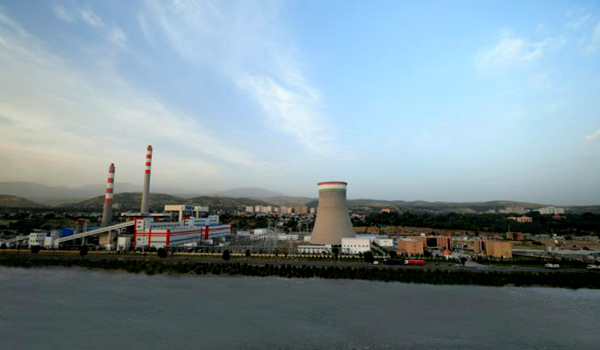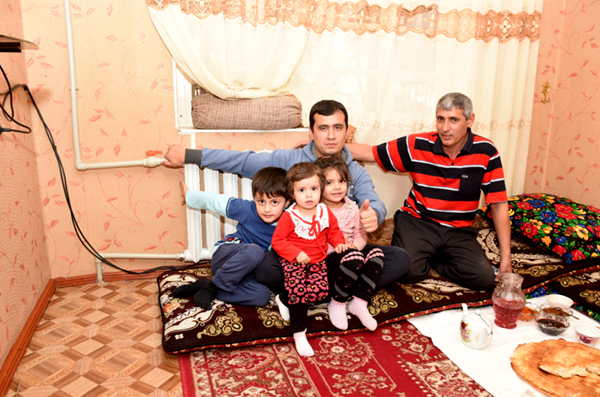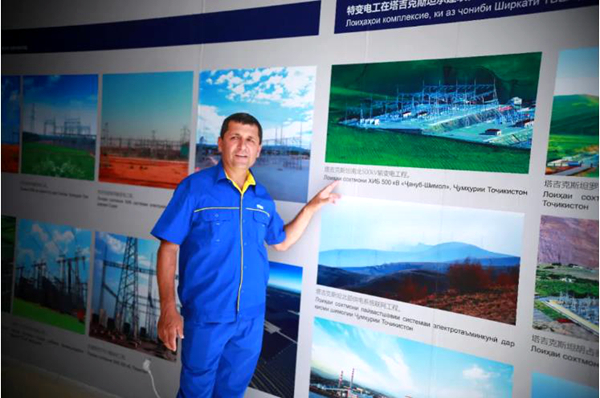Winter in Dushanbe Is No Longer Cold
By Ma Liwenbo
[Tajikistan] Karimov Suhrob Saidmurodovich
Even in the darkest night in the dead of winter, Dushanbe, the capital city of Tajikistan lying at the foot of the Ismoili Somoni Peak, the highest mountain in the country, remains warm and brightly-lit. The transformation came after Tajikistan lifted a 20-year winter power brownout in 2017 and Dushanbe said goodbye to the cold winters it had suffered when it didn’t have sufficient power supply.

Winter Power Brownout Becomes History
Power brownout in winter used to be normal in Dushanbe, which depended on a thermal power plant built in 1957. The power and heating it produced was insufficient and in addition, the plant ran on natural gas but couldn’t get a stable supply of the fuel to meet the needs for the city’s daily life.
Tajikistan has abundant water resources, but its hydropower capacity is low since many small hydropower stations have to stop operation in winter when the waters freeze.
With the protracted power brownout prevailing throughout the country, power shortage hampered the economic development of Tajikistan.

The Dushanbe No. 2 thermal power plant
In winter, families could not use many of their electrical appliances and many industrial enterprises had to stop production because of power shortage. In extreme cold weather, more enterprises had to stop work so that residents’ basic needs could be met first.
The promise of change came when Tajikistan and China signed an agreement to build the Dushanbe No. 2 thermal power plant. The new power plant became the largest thermal power plant in the city, with the capacity to meet 60 percent of Dushanbe’s demand for electricity. The residents are no longer worried about electricity in winter, and the local industrial enterprises do not have to suspend production in winter any longer. The network of aerial transmission lines and underground cables erected by the new project is providing a steady stream of power to improve the lives of the people and facilitate the industrialization of Tajikistan.
Tajik President Emomali Rahmon spoke very highly of the project. “The Dushanbe No. 2 thermal power plant is an important step that we have taken toward the goal of energy independence,” he said. “The strategic partnership between Tajikistan and China has developed rapidly, especially in the field of energy. The power plant is an embodiment of this good cooperation and a model of high-level cooperation between our two countries.”
The leaders of the local mining industry have hailed the plant as a “powerful engine” driving the economic development of the region.
Chinese company TBEA Co., Ltd., which manufactures power transformers and builds transmission projects, developed the Dushanbe project. It has also helped Tajikistan build an independent and complete power support system. More than 10 years ago, TBEA built a 500-kV transformer substation in the suburbs of Dushanbe. It also built a major north-south power transmission artery of Tajikistan, which passes over a plateau 3,800 meters above sea level. Besides, the company has funded the construction of four schools to provide 6,000 local students a modern studying environment.
Warmth in Winter
The No. 2 thermal power plant generates heat along with power, which ensures not only power supply for Dushanbe all year round, but also heating in winter. Although this requirement made the project more difficult to implement, the developer ensured it so that the power project meets Dushanbe’s development needs more effectively.
Previously, most of Dushanbe residents used electric heaters in winter. When the mercury plunged, the whole family would huddle around the electric heater to keep warm. During the power brown-out, when the heaters would not work, they had to switch to coal stoves for cooking and heating, which produced a lot of dust and made them ill.
Dushanbe used to have a pipe network to provide central heating but it had not been working for years. The pipes and radiators in some apartments had been removed and sold. Therefore, before resuming central heating, TBEA overhauled the city’s heating pipe network and installed new radiators in residents’ homes and finally, central heating resumed. People were so moved that they held the workers’ hands tightly in gratitude for a long time.

The winters are no longer cold in Dushanbe.
When Mirzoyev, an employee at the power plant, got back home from work, he was greeted by a stream of heat. His youngest son came running to him, barefoot, took his hand and led him inside. The floor was warm. That evening, when Mirzoyev’s father watched TV on the sofa, the heat made him take off his cotton vest. Earlier, he could never imagine taking it off in winter. Steam arose from the food his wife had prepared and put on the table. He touched the radiator and felt the warmth of happiness at his fingertip.
While restoring the heating, TBEA took care to ensure there were no adverse impacts on Dushanbe’s beautiful natural environment. Green development was a key concept in the whole process of construction. They used advanced standards, environmental protection technology and equipment to monitor the discharge from the coal used for the power station. The resulting waste and ash were treated and recycled. The local residents appreciated their efforts for environmental protection.
Lao So's Sinophilia
Suhrob, affectionately called Lao So by his friends, is one of TBEA’s senior employees. He has three sons, of whom the eldest works as an interpreter at the power plant. The second son is studying in China and has a Chinese girlfriend. The youngest son intends to study in China, having studied Chinese for a year at the Confucius Institute in Tajikistan. Suhrob’s granddaughter listens to popular Chinese children’s songs, including A Lucky Family of Three (Jixiang Sanbao). The whole family is closely associated with China, which has to do with Lao So’s Sinophilia.

Suhrob tells stories of his participation in TBEA projects.
Lao So joined TBEA 13 years ago and worked his way up as a driver, a guide, a translator and a maintenance technician. He has participated in most of the company’s energy and power projects in Tajikistan and witnessed the benefits the No. 2 power plant has brought to his country.
“China’s assistance has brought us brightness and warmth,” he often tells his family. “I’m proud to be a member of a Chinese company’s big family.”
In winter, it is still bitterly cold in Dushanbe with biting winds. But at night, the city is brightly illuminated and inside the apartments, the families bask in warmth and contentment.
FOR MORE
Project Overview
The Dushanbe No. 2 thermal power plant is one of the most important projects of public benefit in Tajikistan. It was built by TBEA Co., Ltd., a Chinese manufacturer of transformers and a developer of transmission projects.
Both phases of the project had been completed in December 2016. With a total installed capacity of 400 megawatts and an annual generating capacity of 2.2 billion kilowatts, the plant can meet 60 percent of Dushanbe’s electricity demand and provide winter heating for more than 700,000 residents, covering 4.3 million square meters.
The project has used advanced technology standards and environmental protection technology to ensure ultra-clean industrial exhaust emission. The fully-enclosed 200,000-ton coal yard reduces secondary pollution and the plasma ignition technology used to ignite the coal reduces oil consumption to zero.
The plant has also nurtured a large number of talents for the development of Tajikistan’s thermal power industry. During the construction and operation of the project, 150 Tajik technicians went to China for training and improved their skills. Also, 300 Tajik operators have learned how to operate the plant under the guidance of Chinese experts.


